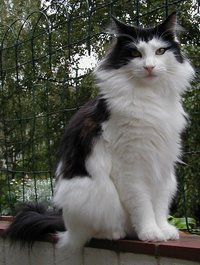
| Skaukatt |
| Norsk Skogkatt |
TICA, FIFe
|
From Wikipedia the free encyclopedia, by MultiMedia |
| Norwegian Forest cat | ||
|---|---|---|
 |
||
| Alternative names | ||
|
||
| Common nickname | ||
| Wegie | ||
| Country of origin | ||
| Norway | ||
| Breed standards (external links) | ||
|
CFA,
ACF,
ACFA,
CCA, TICA, FIFe |
The Norwegian Forest Cat is a breed of domestic cat native to Northern Europe, and adapted to a very cold climate. In Norway they are known as Skaukatts or more properly, the Norsk Skogkatt (literally, Norwegian Forest Cat).
The breed is a very old one which occurred as a natural adaptation to the cold climate of the region, but it was not regarded as anything other than a standard house-cat until the late 1930s, when a small number of 'Skaukatts' were shown in Germany and received very favourably by the judges. World War II brought an abrupt end to the fledgling Norwegian show cat industry, and the breed was forgotten until the 1970s. The cats are now being bred and shown in several countries including the United States. The first international association to accept the breed was FIFe, in 1977.
Norwegian Forest cats have a thick fluffy double-layered coat, tufted ears and a long bushy tail to protect them against the cold. Their coat is essentially waterproof due to its coarse outer layer and dense underlay. They are very large cats with adult males weighing 6 to 10 kg (13 to 22 lb), while females are approximately half that size. Their hind legs are longer than their front legs. They are intelligent, playful cats that enjoy human company. The nickname of "Wegie" began in the United States and is a shortened version of the word Norwegian.
Australia: First introduced in the late 1990s
Japan: First introduced in the early 1990s
United States: First introduced in 1979
Cats, made by MultiMedia | Free content and software
This guide is licensed under the GNU Free Documentation License. It uses material from the Wikipedia.